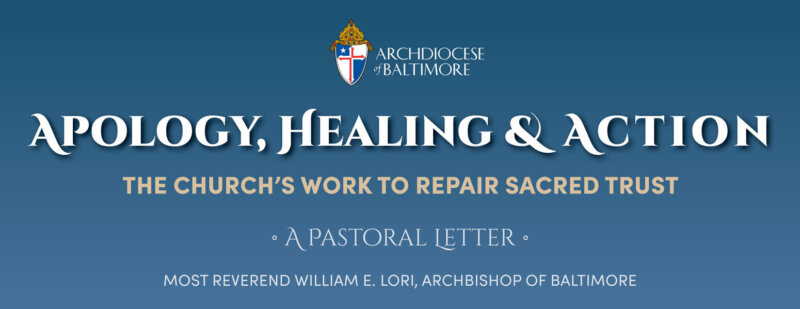Apology
My letter to you about this painful subject can only begin with a heartfelt apology. I offer this as my imperfect attempt. To the victim-survivors, their families and all the faithful of the Archdiocese: I see the pain and destruction that was perpetrated by representatives of the Church and perpetuated by the failures that allowed this evil to fester, and I am deeply sorry.
Moral evil exists anytime one person takes advantage of another. This could include exploiting an immigrant, denying the safety and dignity of the elderly, or using a position of power to control a subordinate. But the sexual abuse of a child by an adult is among the worst moral evils.
The evil of abuse was compounded by the fact that it was committed by those ordained as heralds of the Gospel and ministers of the Sacraments. The exercise of priestly ministry involves a sacred trust intended to represent the holiness of Christ and the goodness of Christ and the love Christ has for His Church and for each person. Using deception and manipulation, these evildoers exploited that sacred trust. Their heinous acts of sexual abuse inflicted untold harm on trusting and vulnerable children. It shattered their innocence and, in far too many instances, ruined their lives.
The behavior of these abusers therefore represents the polar opposite of what any representative of the Church should be. Whenever word of this depravity reaches the consciousness of the faithful, it causes scandal and rightfully elicits anger, repulsion and anguish.
In writing to you, I seek to reflect what victim-survivors have told me, not just since my arrival in Baltimore but over four decades of ministry as a priest and bishop.
By mustering the courage to vocalize their experiences, victim-survivors have helped me understand how the wounds of sexual abuse remain present in their lives, often dominating their thoughts. For some, the wickedness they experienced diminishes their capacity for friendship and intimacy. For others, it has undermined their ability to function day to day, to hold down a job, and to have productive and meaningful work. Still other victim-survivors have been consumed by anger as they grapple with the consequences of the abuse they endured.
For many victim-survivors, the sexual abuse they suffered not only damaged and even severed their relationship with the Church, but it also damaged and even severed their relationship with God. Listening to their experiences, I could only regard such wickedness by representatives of the Church as the gravest of betrayals.
As the report details, this widespread evil tragically operated in the Church for over 50 years, spanning from the attack on Pearl Harbor through the launch of the World Wide Web. Contrary to what some have asserted publically, my predecessors did not want children to be abused but, their response to abuse was woefully inadequate. We know that during this era what was deemed shameful was often buried and the common response to scandal was to keep it quiet at all costs. This was true in families, in society, and, sadly, in the Church. We also know that there was a woefully inadequate understanding of both the lasting harm of sexual abuse and the rate of recurrence of these crimes.
Today, both as a Church and as a society, we have a greater understanding than in the past of the horrible impact of child sexual abuse. This, of course, does not lessen the gravity of these past sins. Tragically, the abuse of minors not only impacted members of the Church, but it is indeed a societal problem that has inflicted harm upon many individuals worldwide. To repeat, this crime is all the more tragic when present within the Church.
Pope Francis confronted this evil in 2019 at the conclusion of the Vatican summit on child sexual abuse in the Church. He said:
“We are thus facing a universal problem, tragically present almost everywhere and affecting everyone. Yet we need to be clear, that while gravely affecting our societies as a whole, this evil is in no way less monstrous when it takes place within the Church.
“The brutality of this worldwide phenomenon becomes all the more grave and scandalous in the Church, for it is utterly incompatible with her moral authority and ethical credibility. Consecrated persons, chosen by God to guide souls to salvation, let themselves be dominated by their human frailty or sickness and thus become tools of Satan. In abuse, we see the hand of the evil that does not spare even the innocence of children.
“No explanations suffice for these abuses involving children. We need to recognize with humility and courage that we stand face to face with the mystery of evil, which strikes most violently against the most vulnerable, for they are an image of Jesus. For this reason, the Church has now become increasingly aware of the need not only to curb the gravest cases of abuse by disciplinary measures and civil and canonical processes, but also to decisively confront the phenomenon both inside and outside the Church. She feels called to combat this evil that strikes at the very heart of her mission, which is to preach the Gospel to the little ones and to protect them from ravenous wolves.
“Here again I would state clearly: if in the Church there should emerge even a single case of abuse — which already in itself represents an atrocity — that case will be faced with the utmost seriousness. Brothers and Sisters: in people’s justified anger, the Church sees the reflection of the wrath of God, betrayed and insulted by these deceitful consecrated persons. The echo of the silent cry of the little ones who, instead of finding in them fathers and spiritual guides encountered tormentors, will shake hearts dulled by hypocrisy and by power. It is our duty to pay close heed to this silent, choked cry.”
Even while recognizing that the Church is made up of people who, like everyone, struggle with sin, human weakness, fallibility— and will until the end of history— the sin of child sexual abuse can have no place whatsoever among those called to minister in the Body of Christ. Stewards of the Church, such as myself and my co-workers, must work tirelessly to ensure this. The sin of abuse is diametrically opposed to the will of God and must be utterly rejected by those who aspire to follow Christ and serve the members of His Body.
For the ways the Church did not root out those who would harm children and properly address the grievous harm committed, and above all, for the suffering of each person who has been abused, I offer my deepest apology.












